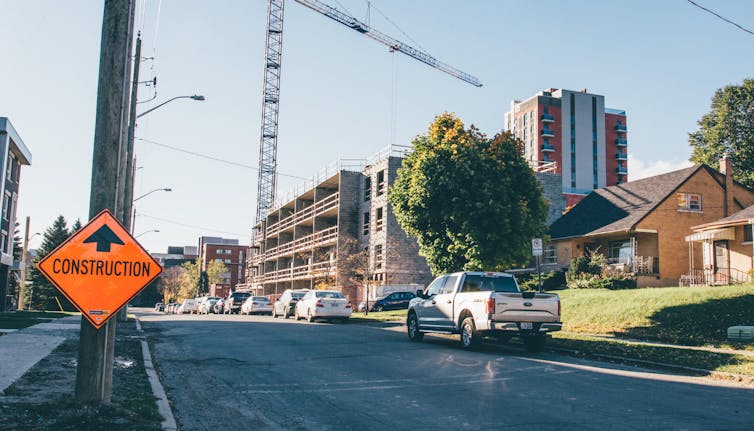Student housing crisis: Municipal bylaws have created roadblocks for decades

University and college students have become a flashpoint in Canada’s national housing crisis.
The federal government is considering a limit on international study permits, something opposed by Universities Canada and scholars and advocates concerned about scapegoating international students for the housing shortage.
Ontario’s Big City Mayors’ caucus has identified the lack of on-campus student housing as a primary driver of housing shortages. Across the country, frustrated students fail to find housing, or are forced into dangerous overcrowded situations. Nova Scotia may release the country’s first student-specific housing strategy.
Recent stories have identified issues like ongoing discrimination against international students in the housing market and a less space-efficient design trend of more individualized student housing units. We’ve also seen discussion about the expanding role of large private investors in student housing who lack institutions’ capabilities to respond to students facing financial difficulties.
Students in Canada and their communities urgently need solutions. Amid finger-pointing at the federal government, individual institutions and the provinces, which fund higher education and set development standards, municipal governments have been largely absent from the discussion.
Yet municipal planning has been hostile to student housing for decades. When this history is coupled with abysmal levels of on-campus housing construction since the 1990s and a doubling of enrolments since 2000, the current crisis seems inevitable.
Restricting where students can live
Our recent study examined 15 Ontario municipalities with a major university campus. We identified four types of regulatory strategies used to control student housing through zoning.
While some municipalities pay students little mind, the most popular approaches are based on attempting to restrict where students can live, or diverting student housing to locations along transportation corridors. These are often on former commercial or industrial sites.
Of the 15 municipalities surveyed, only Waterloo had adopted plans designed to accommodate student housing near campuses.
History of student housing regulation
As long as universities have existed, there have been conflicts between students and other residents.
Generally, these conflicts have centred on disturbances such as boisterous partying or vandalism blamed on students.
Accordingly, municipal policies have sought to regulate student housing to control these perceived issues, overlooking the positive social and economic contributions students make to their communities.
In Ontario, for instance, municipalities adopted bylaws capping the number of unrelated persons who could live together in a housing unit. In our study, we also found many municipalities restricted the conversion of existing housing to rental use. They also limited the development of basement suites or laneway houses in near-campus neighbourhoods.
Explosive student demand
These policies became especially popular in the 2000s. During this time, the province’s “double cohort” in 2003, and subsequent 2005 policy of increasing enrolment by 100,000 spaces, generated explosive student demand in the private rental market. This happened without corresponding funding for new on-campus housing.
These actions attempted to circumvent the Supreme Court of Canada’s decision in Bell v. R, which saw the Court rule municipalities could not regulate who could live together in a residence based on their relationship to each other. In addition, Section 35(2) of Ontario’s Planning Act prevents municipalities from “people-zoning,” or dictating who can live where and with whom.
The Ontario Human Rights Commission issued an unprecedented comment on the City of Oshawa’s Student Accommodation Strategy in 2010, noting students were a protected class of persons under the province’s Human Rights Code.
In the years following, many of these overtly discriminatory bylaws were struck down.
Student housing regulation today
Bans on “people-zoning” have not prevented cities from adopting more covert methods to restrict where students can live. Heritage conservation districts and low-density zoning that prohibits apartments are frequently found near major campuses.
While there may be good reasons to preserve built heritage, limiting the conversion or redevelopment of housing without provisions to house growing student populations leaves them few options.
Ottawa’s most recent official plan identifies the Sandy Hill neighbourhood adjacent to the University of Ottawa as “an attractive residential neighbourhood, especially for family living.”
Little space for students
Even the award-winning official plan for London, Ont., includes the Near-Campus Neighbourhood Planning Area policy in place around Western University and Fanshawe College that aims to prevent “undesirable changes in the character” of surrounding neighbourhoods.
There is, in other words, precious little space for students in the official visions for these neighbourhoods.
Some cities have sought to enable the development of near-campus housing for students and other residents alike. However, while the municipality of Waterloo and Niagara Region seem to be leading the way in construction of new student-oriented housing, the dominant role of private investors in these projects still creates challenges for the affordability and flexibility needed to meet student housing demand.
The path forward
While municipal bylaws are certainly not the only culprit in the contemporary student housing crisis, local governments have far too often been let off the hook for approaches that discreetly limit where students may live.
Certainly, post-secondary institutions need to step up in providing affordable, accessible housing for students, and provincial funding formulas must contribute per-student allocations for the construction and maintenance of on-campus residence buildings.
The federal government, keen to attract international students, could also take some responsibility for the housing demand created by this policy. But municipal plans must also recognize students as valued members of the community who, like anyone else, need a place to live.![]()
Alexander Wray, PhD Candidate in Geography, Western University and Nick Revington, Professeur de logement et dynamiques urbaines, Institut national de la recherche scientifique (INRS)
This article is republished from The Conversation under a Creative Commons license. Read the original article.
No comments:
Post a Comment